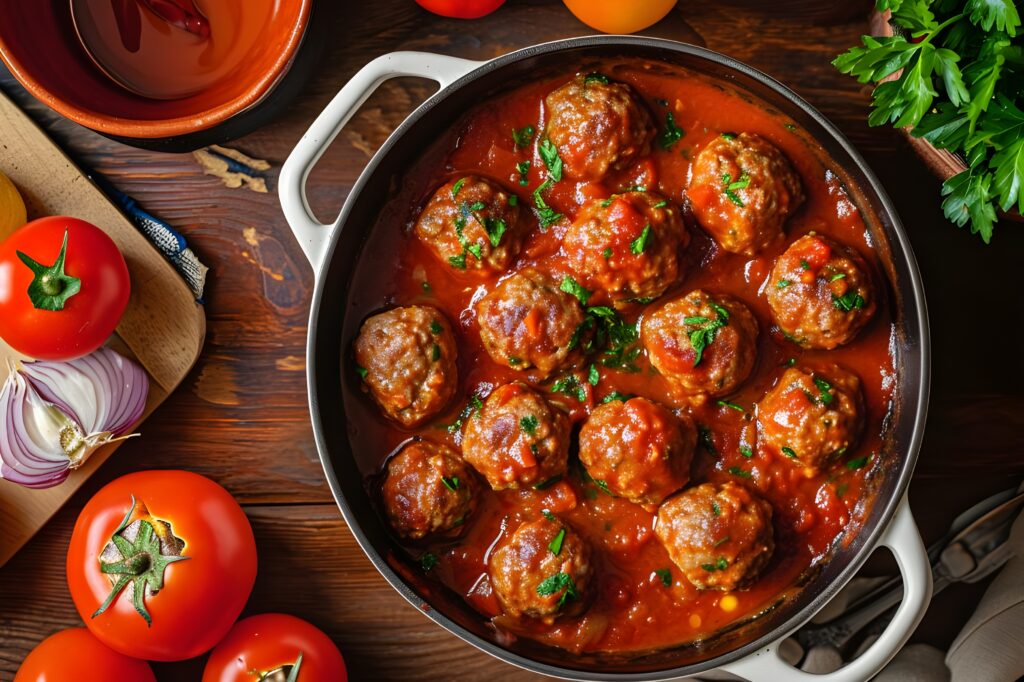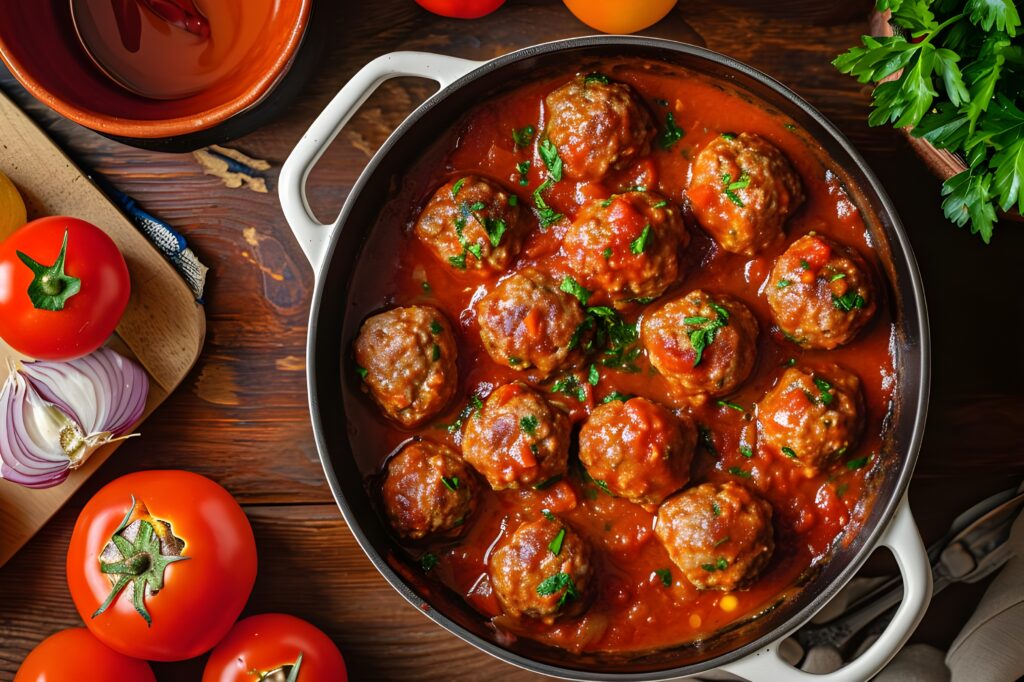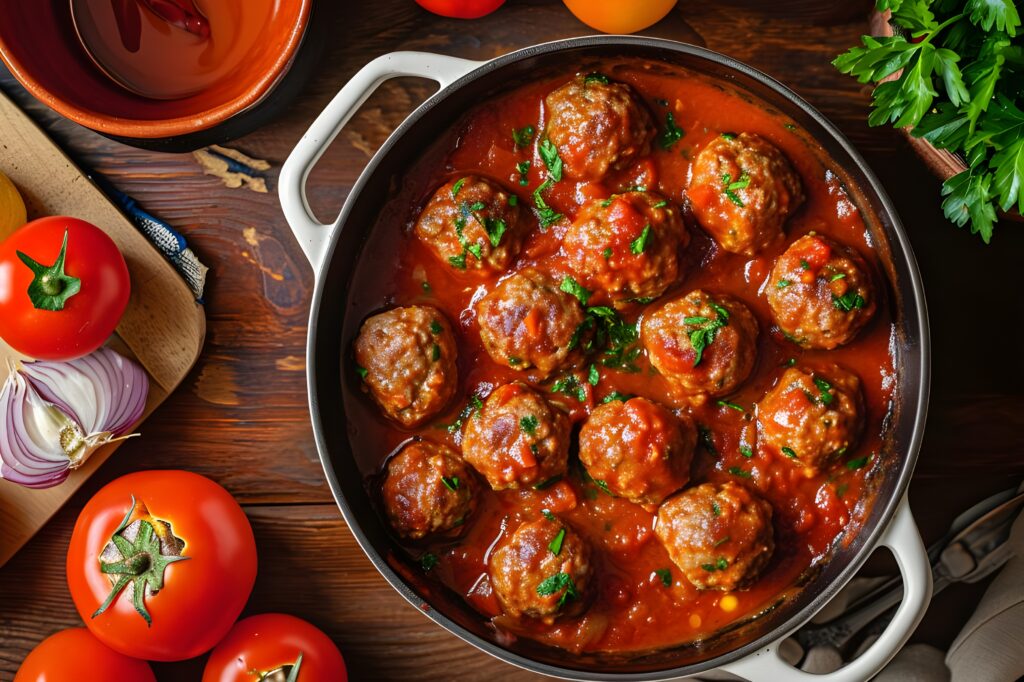Magic Meatballs in Tomato & Wine Sauce

A Friendly, Folkloric Celebration of Flavor
1. A Village Kitchen at Dusk
Picture yourself in a wood‑smoke kitchen at the edge of a small village. It’s dinnertime on a gentle Sunday, and your grandmother, Maria, with flour‑dusted hands and laughter in her eyes, is rolling tiny meatballs with loving precision. She hums an old folk song, and somewhere outside, a goat bleats. On the wood‑burning stove, tomato sauce simmers low and slow, the surface dotted with tiny meatball crowns. A gentle splash of red wine escapes into a hiss, rich aromas rising with steam—this is when home becomes something magical.
Table of Contents
2. Why Magic Meatballs?
- Simple ingredients, unforgettable taste: Ground meat, breadcrumbs, garlic, herbs—transformed into something greater.
- Tomato + wine = an elevated sauce: the alcohol releases fat‑soluble flavors and softens acidity for a rounder, deeper taste.
- Folk elegance: served in rustic bowls, torn basil, olive wood ladle—a tribute to humble roots and shared meals.
- Cook’s touch matters: the final 30 minutes of simmering the balls in sauce is where flavor and tenderness truly meld.
3. A Journey Through Time & Taste
3.1 Ancient Origins
Meatballs aren’t just Italian—they’ve existed since ancient Rome and even earlier in the Middle East and Asia. Historians trace the earliest versions to Persia and the Middle East, with meats mixed with grains and spices, then shaped and cooked.
3.2 Italy’s Gift to Meatballs
In Milan lies the mondeghili, a polpetta made of leftover meats, breadcrumbs, eggs, herbs—pan‑fried and served alla Milanese.
3.3 Ragù & Italo‑Folk Traditions
By the 18th century, French ragoût influenced Italian meat‑and‑tomato sauces, especially in Emilia‑Romagna, giving rise to ragù that included wine and a soffritto base. In Naples, marinara (meaning “sailor‑style”) was quick on a ship’s galley: tomatoes, garlic, olive oil, oregano—they sometimes added wine, too.
3.4 Italian‑American Sunday Sauce
In the early 1900s, immigrants in New York fused tomatoes from America with meatballs—creating the iconic spaghetti and meatballs. Sundays became sacred: the sauce simmered all day while families gathered to eat and reconnect.
4. Why Wine Makes the Sauce Magical 🍷
Whether red or white, wine chemically intensifies flavor:
- Alcohol acts as a solvent, pulling out deeply embedded flavor molecules that water can’t release.
- Acidity & tannins in wine help neutralize tomato sharpness and smooth the meatiness.
- As it reduces, the sauce becomes more rounded—sweetness and brightness balanced in a savory full-bodied hug.
For tomato‑wine sauce, choose a drinking‑grade dry red—Chianti (Sangiovese) is ideal; high tannins like Cabernet need fat buffers to avoid bitterness.
5. Ingredients — Generous & Say-it-in-village Terms

| Ingredient |
|---|
| 1 lb (450 g) 80/20 ground beef or veal‑beef mix |
| ½ lb (225 g) ground pork or lamb |
| ⅓ cup stale white bread crumbs |
| 1 egg |
| ¾ cup finely grated Parmigiano‑Reggiano (or Pecorino) |
| 2 garlic cloves, crushed |
| 2 Tbl chopped flat‑leaf parsley + 1 tsp chopped oregano |
| Pinch ground all‑spice + pinch black pepper + pinch coarse sea salt |
| 2–3 Tbl extra‑virgin olive oil for frying |
| 1 medium onion, finely chopped |
| 2 garlic cloves, minced |
| ¼–⅓ cup dry red wine (Chianti, Sangiovese, or Pinot Noir) |
| 2 cups quality tomato puree (san marzano or homemade) |
| 1 Tbl tomato paste |
| Fresh basil leaf, bay leaf, optional sprig rosemary |
| Salt & pepper to taste |
| Splash of milk (optional, for lighter tenderizing) |
6. The Method — Step by Step, Heart-First
6.1 Make the Meatballs
- Combine ground meats, breadcrumbs, egg, cheese, garlic, and herbs in a bowl. Add salt, pepper, and all‑spice; if you wish the texture lighter, stir in a spoon of milk.
- Fold gently—no over‑kneading. You want tender centermost bites.
- Form golf‑ball sized dumplings (about 1¼″ diameter). Uniformity equals even cooking.
6.2 Brown the Balls
- Heat 2 tablespoons olive oil in a heavy pan or Dutch oven (cast iron or enameled).
- Sear the meatballs over medium heat, turning every 2–3 minutes until golden on all sides. Avoid over‑crowding; do 2 batches if needed. Remove and drain on paper towels.
6.3 Build the Sauce
- In the same pan, add another splash of olive oil; sauté onion on medium‑low until translucent (5–7 minutes). Add minced garlic and stir 1 more minute.
- Deglaze with wine: pour in wine and simmer until reduced by half—this evaporates alcohol and deepens flavor.
- Stir in tomato paste, then tomato puree, herbs (bay leaf, basil, rosemary), salt, and pepper.
- Bring to a simmer; don’t rush—good sauce needs time.
6.4 Simmer Together
- Gently nestle the browned meatballs into simmering sauce.
- Cover with lid slightly ajar; simmer over very low heat for 30–45 minutes—the magic time. Stir gently occasionally to prevent sticking.
- Remove lid for last 10 minutes if sauce is too watery—it should thicken and cling to the meatballs.
6.5 Finishing Touches
- Check seasoning and adjust salt or pepper if needed.
- Remove bay leaf. Tear fresh basil over top.
- Plate in warmed shallow bowls; drizzle with olive oil. Finish with fresh parsely and fine cheese.
7. Plating Folk Elegance
When serving, place three meatballs in a shallow bowl. Ladle around them generous sauce waves so each dip hits its molten depth. Scattered basil petals, tiniest strip of Parmesan curls, and a small glass carafe of olive oil gracefully rest beside, like gifts from the farm. Rustic bread or thick polenta rounds are positioned to soak up the sauce—not just food, but ritual.
8. Tips from the Hearth (Your Village Kitchen)
- Use day‑old bread for crumbs: seal with milk, then squeeze out excess—crumbs should bind but not soften into mush.
- Cold meat mixture: refrigerate the blended mix 10 minutes before rolling for easier shaping.
- Pan‑frying vs. baking: frying gives browning flavor; baking at 400 °F (205 °C) for 15–17 minutes is healthier, then finish in sauce.
- Double‑taste test: some jars of tomato puree are too acidic or sweet. For store‑bought sauce, boost umami with a teaspoon of Worcestershire or soy sauce, a sprinkle of cocoa powder, honey, or pesto—simple upgrades beloved in community threads Simply Recipes.
- Wine choice matters: choose a wine you’d enjoy drinking. Avoid cheap cooking wines; they may leave off‑notes when reduced.
- Slow is key: low, almost whisper‑level heat unlocks slowly buried flavors.
9. Variations — Your Own Folk Legacy
- Lamb or beef+lamb meatballs with rosemary—great for winter gatherings.
- Chicken or turkey meatballs—lighter, best with white wine, lemon zest, or parsley.
- Vegetarian option: blend cooked lentils, cooked rice, ground walnuts, egg crumbs, cheese—then simmer in tomato wine sauce just the same.
- Spicy twist: add ½ tsp red pepper flakes; pair with smoky sausage in sauce.
- Trio of herbs: add chopped basil, oregano, and tarragon—gives perfumed brightness.
10. What to Serve & What to Sip
| Companion | Folk charm |
|---|---|
| Pasta | Spaghetti, bucatini, or pappardelle—long strands for sauce to cling. Sprinkle with cheese and pour sauce slowly over pasta like your grandmother’s wisdom. |
| Crusty bread or polenta | Tear and mop, slow down the pace—each crumb drenched in memory. |
| Red wine pairing | Sangiovese, Chianti, or Tempranillo—echo the sauce flavors. Serve a small glass as you cook, another at the table. |
| Side salad | Arugula, shaved fennel, olive oil & lemon—sharp brightness to balance the rich sauce. |
| Garnish | Torn basil, micro‑greens, olive oil swirl, toasted herb/pine nut garnish. |
11. Serving & Sharing: Make It Your Family’s Ritual

- Weekly tradition: pick a Sunday or quiet weekday evening, gather around press‑table, pop on soft folk music (acoustic guitar, accordion). Roll meatballs together.
- Family participation: kids can match ball pairs; adults stir sauce; voices mix with cooking aromas.
- Memory jar: at the table, each guest shares a fond memory or future dream—meatballs become a bridge across generations.
12. Frequently Asked Questions (Folk FAQ)
- Why simmer a full 45 minutes?
Gentle heat allows the sauce to penetrate the meat, tenderize, and concentrate flavors. Skip that, and you’ll miss the velvety finish. - Can I freeze the meatballs?
Absolutely. After browning (but before simmering), freeze arranged on wax paper in a single layer. Then later thaw and simmer as directed. - Can I skip wine?
No problem—use beef or chicken broth, or balsamic vinegar diluted in water. Sauce will still be tasty, just missing the wine’s depth and acidity balance. - Need gluten‑free or low‑carb options?
Replace breadcrumbs with almond meal or gluten‑free mix; serve over zucchini noodles, spaghetti squash, or sautéed rapini. - Can this be vegan?
Yes—swap meatballs with veggie‑lentil balls and finish with vegan cheese or nutritional yeast.
13. A Cultural Note: Sunday Sauce as Folk Anchor
Italian‑American families elevated Sunday sauce beyond mere recipe—it became a ritual of continuity. Immigrant families used modest income to prepare sauce on Sunday so the flavors would span into Monday; gatherings around the table symbolized survival and identity in a new land. That emotional resonance created a dish that’s not just food, but family in a bowl every week.
Now it’s your turn to create that same magic: a bowl, a simmer, a song.
14. Final Word: Cook with Heart
Cooking the Magic Meatballs in Tomato & Wine Sauce isn’t just about ingredients—it’s about ritual, memory, and generosity. From shaping each sphere of seasoning to stirring the sauce as memories rise like steam, you’re not just cooking a meal, you’re carving tradition.
Gather around that pot. Listen to the soft hiss of red wine joining tomato. Taste a morsel still warm from the simmer. Notice how folk elegance isn’t about frills—it’s about care. Lift your wooden ladle, serve with worn bowls, share with your favorite people. That’s real magic.
Enjoy this dish with open hearts and full bellies. May each bite carry the warmth of the village kitchen—and become a memory you return to, again and again.
Try this today also:
Chicken Tikka

